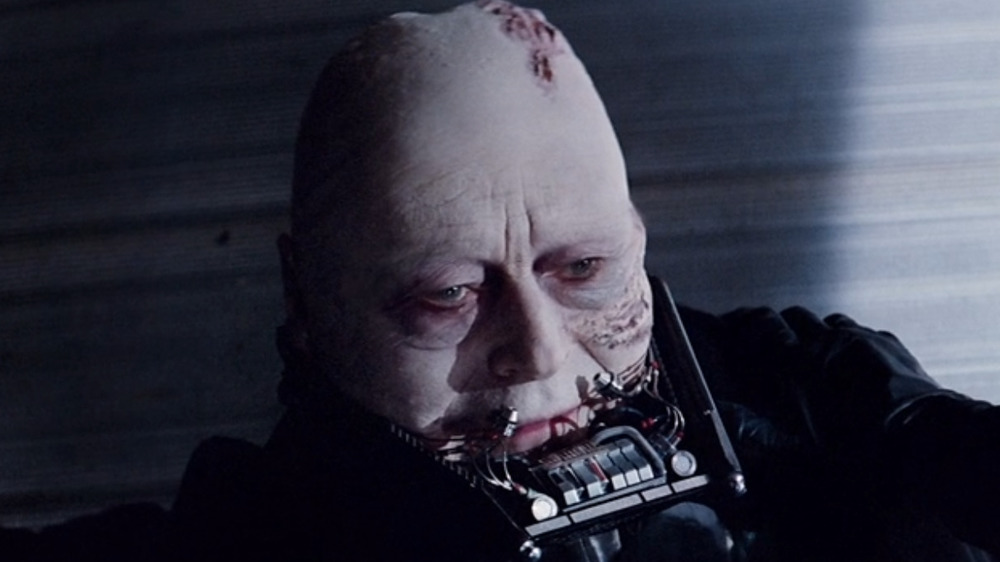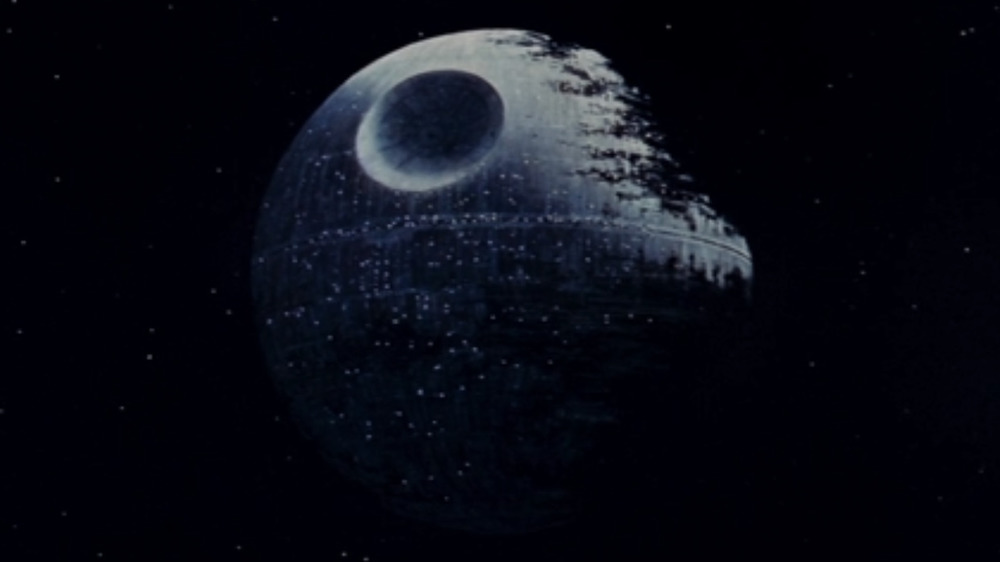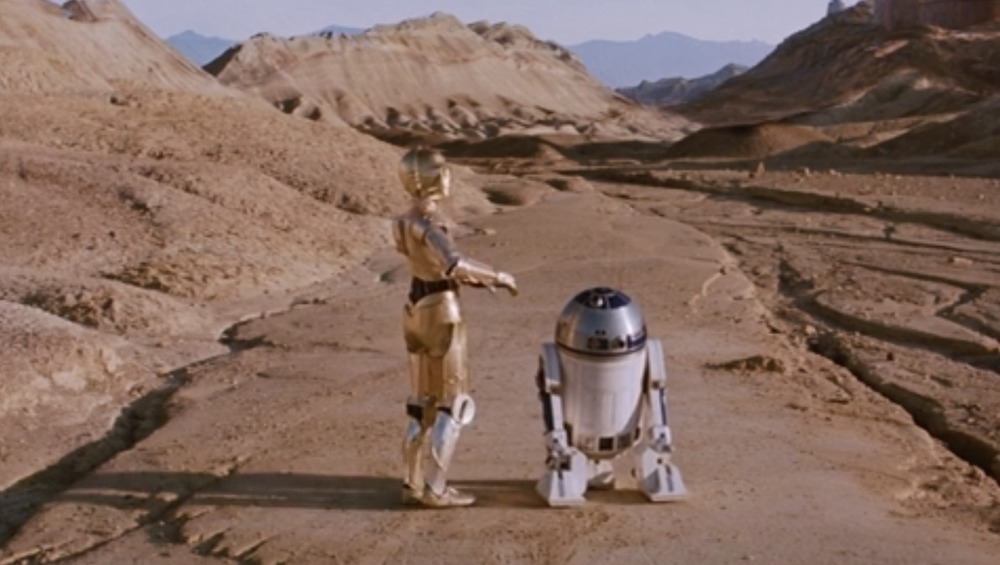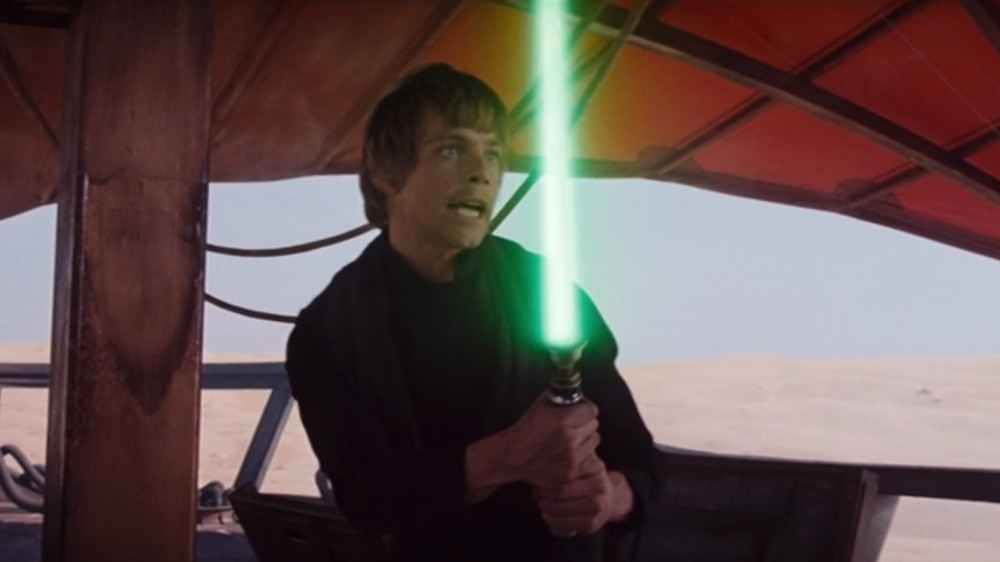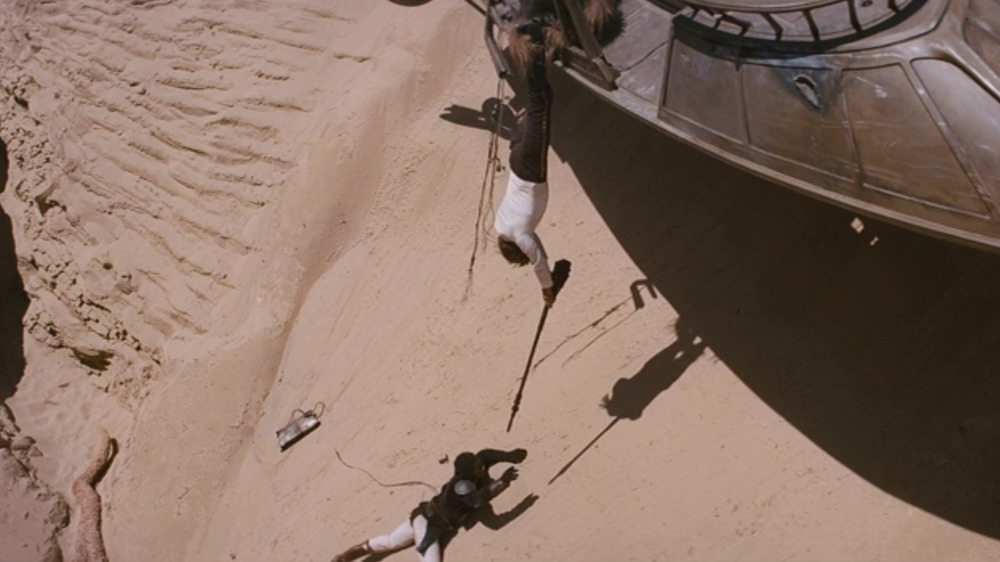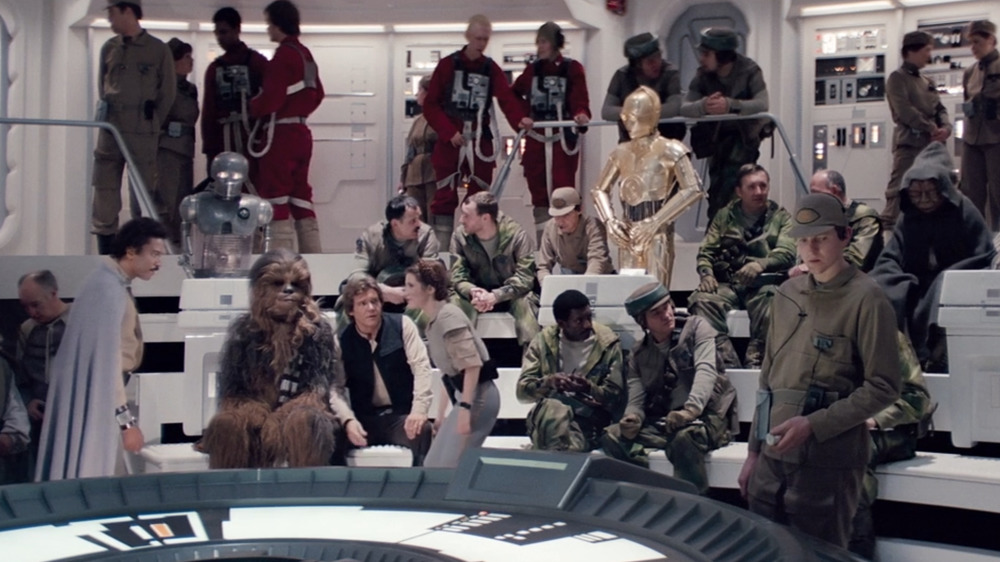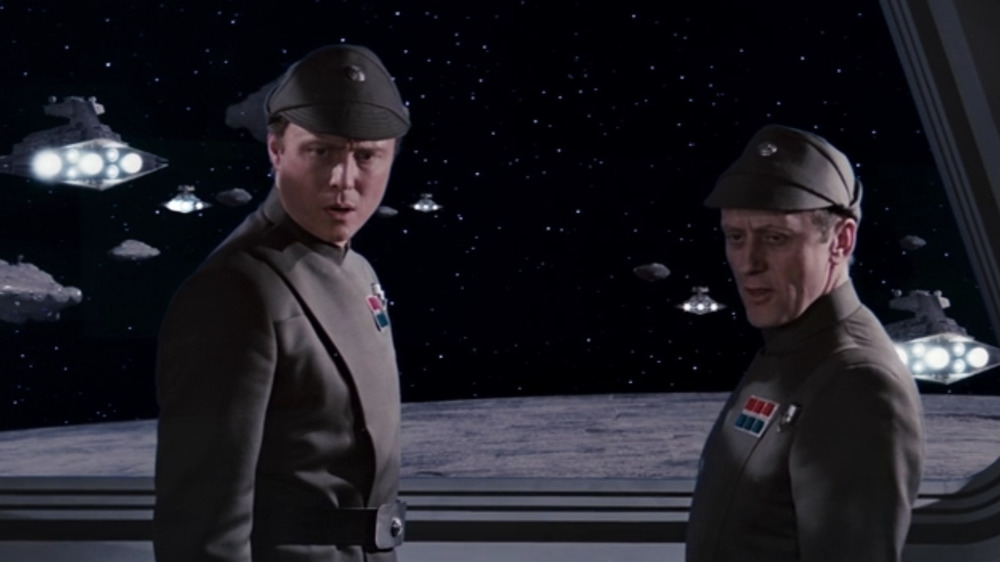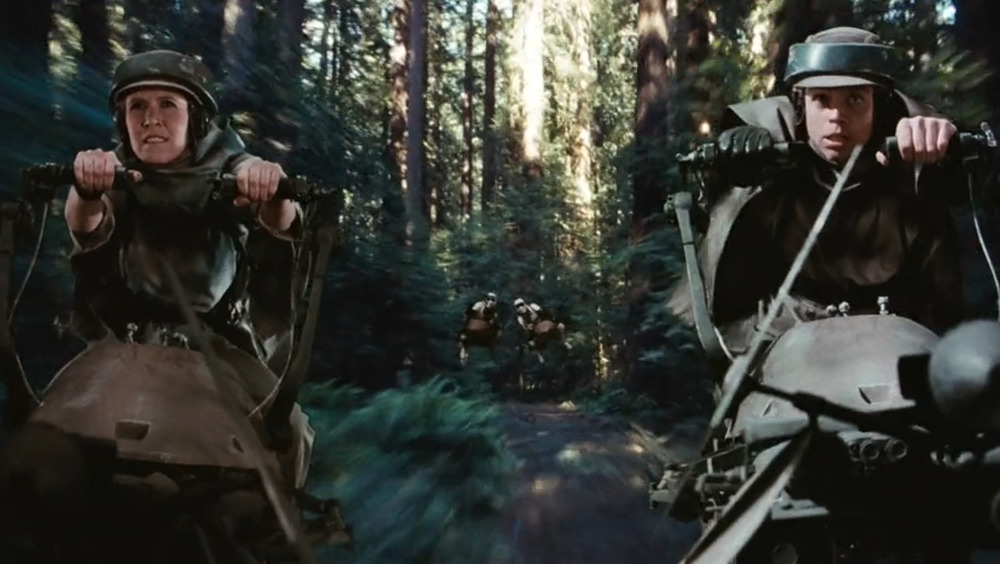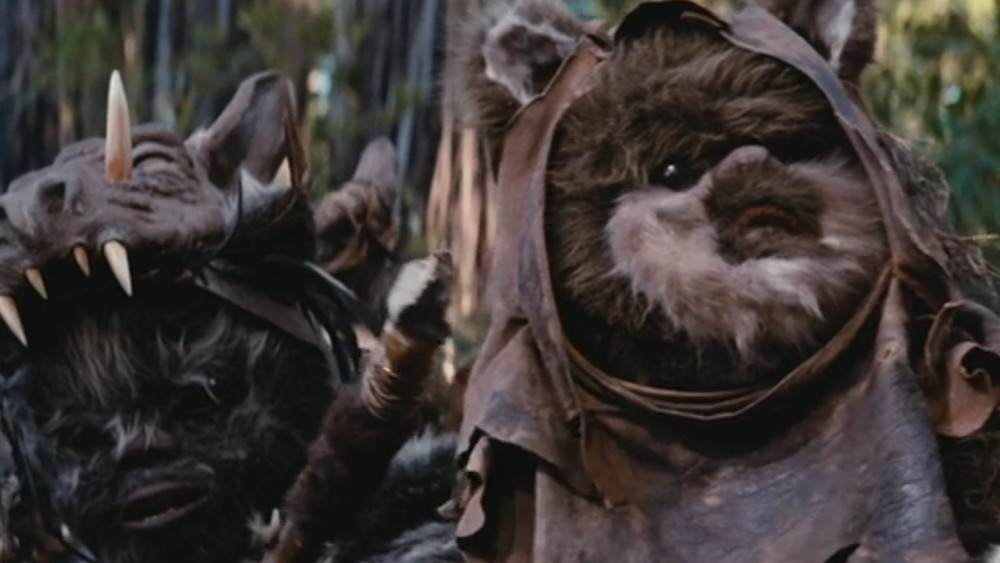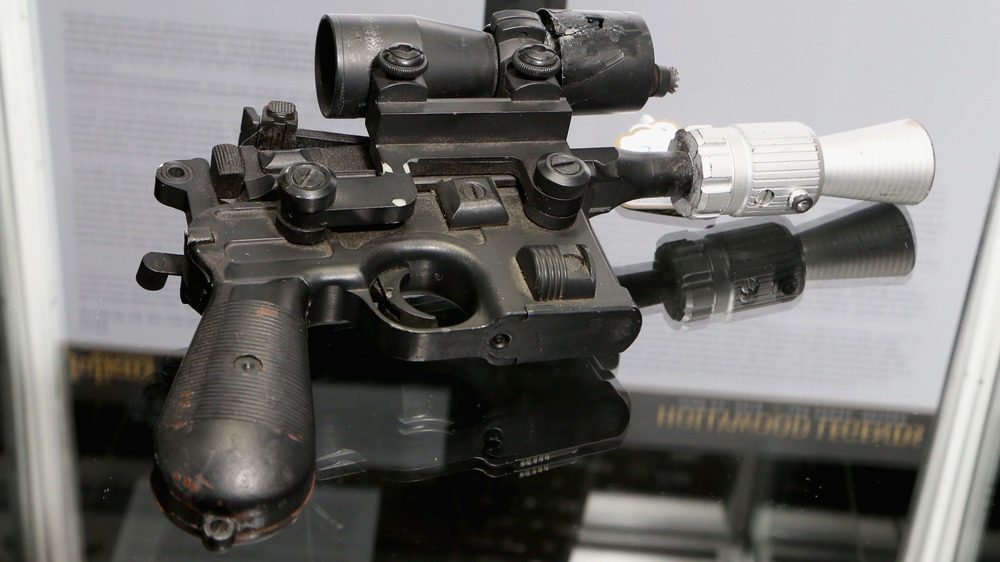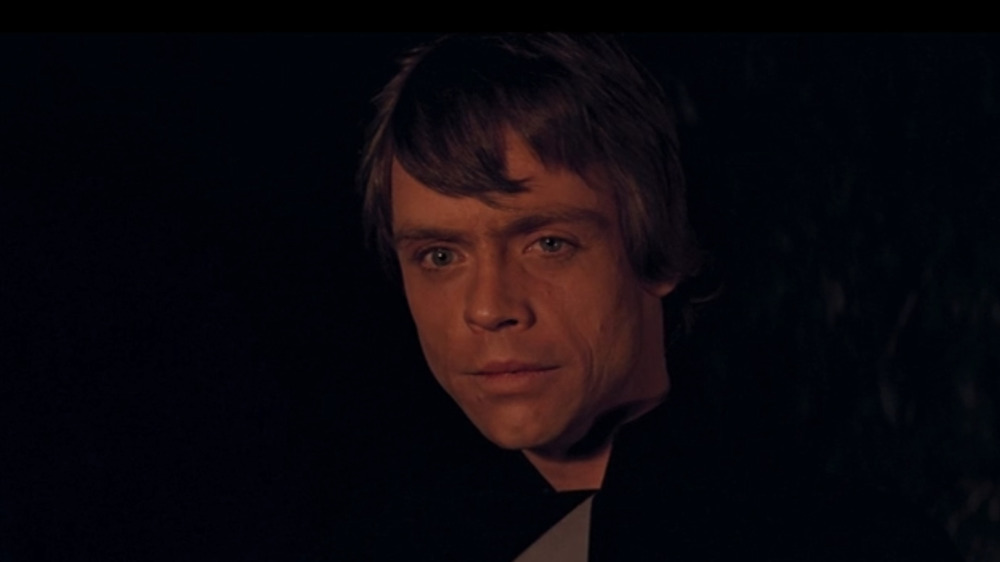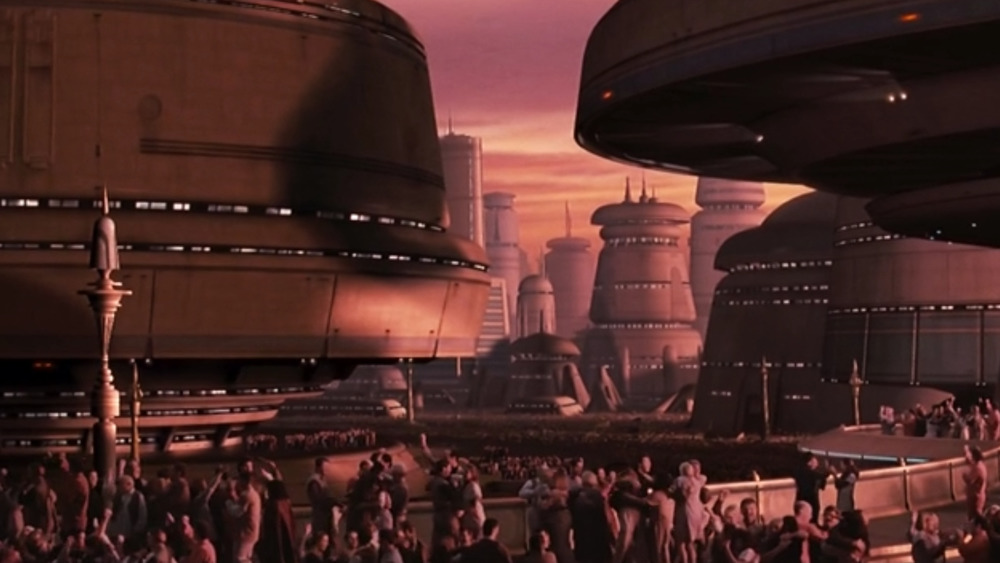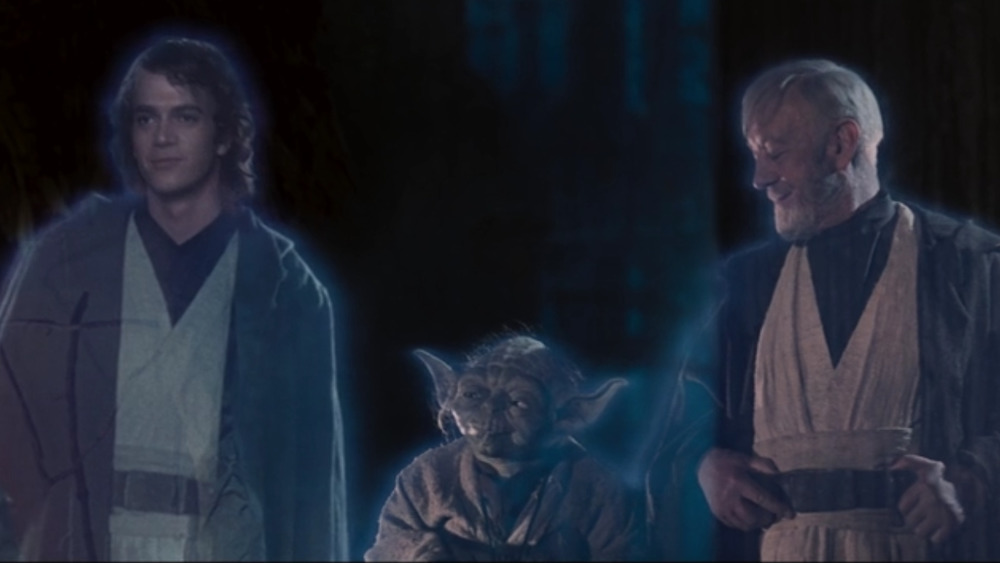What The Final Days On The Set Of Return Of The Jedi Were Like
Return of the Jedi was the end of an era. Star Wars wasn't over, but it was about to take over a 16-year hiatus, and no one could be sure it would ever really be back. At the time, it felt like this might be it. A cultural phenomenon was coming to an end.
It was enough to make the final days of filming feel momentous. Some of the people involved – Mark Hamill, Carrie Fisher, Harrison Ford, George Lucas, and a whole host of special effects artists and crew members — had been there from the start, and they were about to see their work come to a close. Some of them were thrilled to be a new part of the story and could barely believe it was all about to end.
But even if emotions were running high, there wasn't much time to dwell on them: The production schedule was too busy, and new problems kept popping up to make it even busier. It was a hectic time to try to consider the legacy of Star Wars. This is what the final days on the set of Return of the Jedi were like.
All around them, the franchise was hitting milestones
When production on Return of the Jedi began, Star Wars was already huge. Unlike the two previous entries, this movie had to be shot under a fake title – Blue Harvest — to keep vendors from raising their prices to take advantage of a franchise they assumed had to have deep pockets. The title also helped shield the film from fans and press who might have wound up mobbing the sets. Everyone committed to the ruse, turning out jackets and caps with the Blue Harvest logo and putting it on their invoices: The Blue Harvest-branded items are collector's memorabilia today.
As the shoot neared its end, Star Wars kept getting bigger, raising the stakes for what the cast and crew were putting together. In May of 1982 – the month production on Return of the Jedi wrapped — the original Star Wars was first released on VHS to video rental stores. Suddenly, fans could bring at least one of the movies home and watch it as many times as they liked: the perfect way to continue building a rabid fan following and get audiences excited for the upcoming release. It was getting clearer all the time that everyone was waiting to see how Return of the Jedi would turn out.
The cast made one last trip to the desert
The desert planet of Tatooine is arguably the signature location of the Star Wars series. So revisiting the desert to film another Tatooine sequence — this time set on Jabba the Hutt's barge, around the Great Pit of Carkoon — was a kind of bookend for the cast and crew as well as for the characters. It was time to say goodbye to one of the series' great sets.
Even though, in this case, it wasn't the same desert. Back during the filming of the original Star Wars, Death Valley and Tunisia had stood in for Tatooine. This time, as Southwest Living explained, the movie went to Yuma, which had the dunes George Lucas wanted for the Dune Sea.
Revisiting the desert was necessary on a storytelling level, but it wasn't necessarily much fun for anyone who had to make the trip in real life. No one was thrilled about the heat, the dust, or for that matter, the sandstorms, which J.W. Rinzler's The Making of Star Wars: Return of the Jedi also confirmed, noting that they "often brought production to a standstill." Sometimes what's meaningful in fiction is a big hassle in real life.
The last scenes usually came down to choreography
Return of the Jedi has a lot of action scenes, and the last two filming locations were all about getting them right.
In some cases, the crew could work on the choreography by taking the actors out entirely. For the speeder bike chase, as visual effects artist Dennis Muren explained in an interview with StarWars.com, "We ended up building smaller bikes for most of the shots that were like a foot and a half long or so, about a foot tall, with puppets on them, that we could shoot from a distance. So I could get the long shots and make the choreography look good." The actors would be visible in close-ups, but the smoothness of the action sequence would be sold by the puppets, which were undeniably easier to move around.
But sometimes there was no way around using the actors and stunt artists themselves. In The Making of Star Wars: Return of the Jedi, J.W. Rinzler talked about how spending so much time on fight scenes could get wearying and frustrating for the actors. They were especially hard on Carrie Fisher, who longed for more peaceful, emotionally nuanced scenes.
Finally, after weeks of action choreography, she got to go out on a high note: One of her last scenes on location was the conversation on Endor where Luke reveals they're brother and sister. It was like a sweet respite at the end of some very hectic days.
No one had a tougher time than the stuntmen
One of the last stretches of on-location filming happened in Yuma Valley, standing in for Tatooine. It was time to film the sequence with Jabba's barge and the sarlacc pit — which meant it was time to push all the film's stuntmen to their limits.
The sarlacc pit provided a lot of opportunities for stuntmen: a SyFy Wire article with stuntwoman Adair Moran ranked it as the third best stunt scene in the series. But it also meant a lot of dangerous work. Stuntman Julius LeFlore, speaking with Star Wars Interviews, explained, "It was a very grueling and physically demanding job. A lot of people, crew members, were getting hurt." Stuntman Dickey Beer spoke to The EntJunkie about the one upside of taking the slide down the sarlacc's gullet: In the middle of the hot desert, the dark underside of the pit didn't just have the cushioning airbag. It also had one of the few spots of shade. The downside was the danger in getting there — and that the hole came complete with snakes and scorpions.
Things didn't get any easier when they moved on to Crescent City and the Battle of Endor. Kevin Thompson, who did most of the Ewok stunts, told Star Wars Interviews, "Unbeknownst to me...the set dressers would redress the set with gigantic six-foot ferns. Once we were rolling those six-foot ferns would knock out the entire Ewok clan like the Three Stooges."
The fans finally found them
Filming Return of the Jedi as the fake, unrelated movie Blue Harvest was supposed to help production go smoothly. Fans wouldn't surround the on-location sets and disrupt the filming, because the fans wouldn't know the Star Wars crew was even there.
But, of course, the fans found them anyway. According to Southwest Living, the Yuma Valley shoot kept getting disturbed by Star Wars fans who had caught on to the ruse and would go off-roading over the dunes to get a glimpse of the Tatooine set. Yuma local Robert Gwinn, then a teenager, just went to the set with his friends to investigate the filming of any movie: It was something to do. They gawked a little...and then they saw Boba Fett. He recalled, "Then it was like we were yelling 'They're making Star Wars!' at the top of our lungs. Suddenly now we are like giraffes and are stretching as much as we can, hoping to see anything we could." That got them plenty of attention, and a crew member quickly arrived to ask them to leave.
It was great for the fans, but it wasn't so great for the cast and crew, especially as word started to leak out. Director Richard Marquand valued quiet on set, which didn't always mix with a lot of onlookers.
It all ended in front of blue screens
Director Richard Marquand brought his cast from London studios to Arizona deserts to California redwood forests, but they finished their work in front of blue screens at Industrial Light and Magic in San Rafael, California. It took a week and a half to finish up there, and it was an important stretch of time. In a profile with American Cinematographer, producer Howard Kazanjian emphasized how much ILM's work could keep the film under budget: without ILM, he said, Return of the Jedi might have cost $50 million to make instead of its budgeted $32.5 million.
So that week and a half mattered. ILM was able to fill in some background shots with matte paintings, making it easier for the characters in the movie to "visit" different locations. While some of ILM's work was done in post-production, after the last days on set, some of it took place right alongside the actors.
Carrie Fisher told J.W. Rinzler, author of The Making of Star Wars: Return of the Jedi, that the ILM team "were really all very solicitous and sweet." It made for a homey environment. If the work for the actors was often dull, since it was all action in front of a blank background, the stable environment meant the company was good enough to make up for it.
They had to wrap up the tricky speeder bike chase
One of the most difficult scenes in Return of the Jedi was the speeder bike chase through the forests of Endor. J.W. Rinzler's The Making of Star Wars: Return of the Jedi confirms that it was one of the final pieces of the film to click into place — and it only clicked after a lot of effort from everyone involved.
Visual effects artist Dennis Muren explained to StarWars.com how the scene wound up being a combination of puppetry and blue-screen work. Everything had to be planned out in advance, so Muren put together "a little set, with GI Joes and little figures, and little cardboard tubes painted brown for trees, and a shag carpet on the ground that looked like forest floor" to block out the shots they would need. Industrial Light & Magic's official website described how Steadicam footage from a California redwood forest was dramatically sped up to get the right blue-screen background.
The actors spent most of their last days on set sitting around on the speeder bikes. Rinzler quotes Carrie Fisher: "That was one of the most boring things we had to do. We'd just sit there and they'd put this wind machine on us and we'd grimace. I used to read. I was reading Colette and they filmed me, which ended up on a goodie reel; they showed me reading on the speeder bike as I was zooming through the forest."
The Ewoks were relieved to get out of costume
There were a lot of emotions in the air as the production of Return of the Jedi started to wind down, but one of them was relief.
The people who were most relieved? The Ewoks — or, more accurately, the actors and stuntmen who had to spend most of the hot Crescent City shoot inside furry Ewok suits. Stuntman Kevin Thompson, who played one of the most daring Ewoks, was frank with Star Wars Interviews about the difficulties of working in the costume: "In the costume I couldn't really see because the eyes in the costume would fog up from my body heat. Fur and foam does not breathe." His vision in the costume was so bad that he had to memorize the steps in any running sequence in advance, so he could pretend to be dodging explosions that he couldn't actually see.
Only one Ewok really bucked the trend. In his memoir Size Matters Not, Warwick Davis described how crushed he felt as a kid having to walk away his place in Star Wars: "While many of my fellow Ewok actors were truly grateful that their costumed torture had finally come to an end, I moped about miserably."
Still, the person with the worst costume luck was really Peter Mayhew. Given his Chewbacca costume and their filming location out among the redwoods, the crew was constantly worried a hunter would mistake him for Bigfoot.
The fate of Han's blaster
A lot of Star Wars fans will tell you: Han shot first. But his famous blaster went last.
As production wrapped on Return of the Jedi, prop master Peter Hancock turned one of Han's signature display blasters — the "BlasTech DL-44" — over to his friend, ROTJ art director James Schoppe. Schoppe deserved a commemorative gift: He was a late arrival to the franchise, and he hit the ground running, solidifying the look of now-iconic sets like Jabba's barge and the forest moon of Endor. Hancock was also new to the series, and he and Schoppe had hit it off immediately. Schoppe felt the same, later reminiscing to Antique Trader that Hancock was "just [a] wonderful human [being] from the get go ... talented and funny and a great collaborator." Hancock wanted to honor that friendship and their teamwork.
At the time, Schoppe said, it felt like "Star Wars was over." But Star Wars came back, and so did the blaster. In 2018, Schoppe put his cache of Return of the Jedi memorabilia up for auction. He had a treasure trove of artifacts, but nothing caught fans' attention quite as much as Han's blaster. The prop eventually went to Ripley's Believe It or Not for $550,000, which also owns Luke's lightsaber from The Empire Strikes Back.
What happens next?
As Return of the Jedi ended, the cast and crew turned to where they would go next.
According to J.W. Rinzler's The Making of Star Wars: Return of the Jedi, George Lucas wanted to move on: "I'm not having fun...I smile a lot because if I don't everyone gets depressed. But I'd rather be home in bed watching television....I'm only doing this because I started it and now I have to finish it." He would move on to Indiana Jones and the Temple of Doom, which was already in the process of coming together. Harrison Ford was also already attached to the project and excited to work with Steven Spielberg again. They had something they could look forward to.
Mark Hamill and Carrie Fisher weren't so sure where their lives were going. An article on Southwest Living showed their concerns about what would happen once Jedi wrapped. Fisher felt like she was seen as Leia rather than as herself. What would that mean for her career? Hamill was likewise worried he would only ever be seen as Luke Skywalker. He was considering leaving movies behind for a while and doing theater instead: "[Right now] if the audience cheers when I do this or that, it's really for Luke, not for me...[in a stage show] I know it's for me." Since the cheers for Luke were about to die down, it was good to imagine he'd get some for himself in the near future.
People were already imagining prequels
As Return of the Jedi wrapped up, the prequels were still officially on hold. George Lucas had started brainstorming them years before with A New Hope and The Empire Strikes Back producer Gary Kurtz. But before plans could move forward, Lucas decided that the technology he needed to make the movies didn't exist yet. He wanted more spectacle — enormous cities, more costumes, a more mobile Yoda — and he didn't yet have the means to get it. On top of that, he had family pressures that made him reluctant to take on another time-consuming trilogy.
But Den of Geek recently unearthed an old interview with Richard Marquand, the director of Return of the Jedi, just a year after the film's release. In it, Marquand demonstrated that belief in the prequels — or "preludes," as he calls them — was alive and well, no matter what Lucas said. He hoped to direct one of them, and so, he told interviewer Jules-Pierre Malartre, did Steven Spielberg. But, he added, "It will take a long time, I'm afraid...It's just a fact we will have to face. Good things come in threes, and all good things come to an end."
Unfortunately, since Marquand passed away in 1987, he never got his chance to return to the Star Wars universe. But we now know that he — and probably plenty of other on-set fans – never stopped hoping that there would be more.
The end was bittersweet
As Return of the Jedi came to an end, the cast and crew felt wistful.
Some were sorry it was ending but still glad to have a change of pace. Richard Marquand said that when he got the offer to direct, he "felt like a young man who knows the music of Beethoven extremely well, and who is finally asked to play it with the London Symphonic Orchestra." But the shoot had also meant a lot of time dealing with malfunctioning robots, so he told American Cinematographer that he was ready to make a movie that was just about people spending most of the movie in bed.
Others dodged the sense of an ending. In a post-movie interview, Carrie Fisher said that it didn't feel like the experience was over because the friendships from it went on: "We still continue to see one another even though we don't have footage of it."
In J.W. Rinzler's The Making of Star Wars: Return of the Jedi, Mark Hamill said he had always had trouble with goodbyes, and this was no exception: "[This] was the final time that I was playing this character with these people I'd grown to love so much. Part of me never wanted it to end." Ultimately, ending the original trilogy was painful but moving — the closing of one door and the opening of others.
